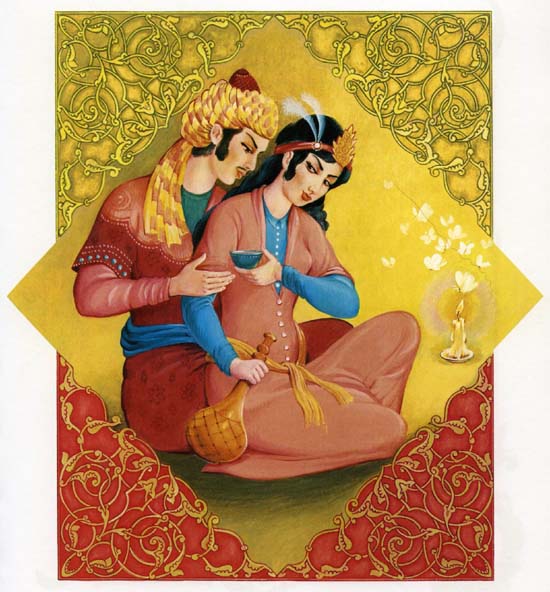
The one of which I write today follows the usual iconography of Khayyam: wine and woman, desire and transience. It is not much different, let us say, from picture twelve on the four times four table. The only important difference is the candle in the background which attracts with its flame the night butterflies.
The image of the butterfly immolated in the light of the candle is one of the most important motifs of classical Persian poetry. Annemarie Schimmel, the greatest Western expert of Sufism writes in her A Two-Colored Brocade. The Imagery of Persian Poetry, 1992 that there is no more popular poetic animal than this, except for the nightingale (about which we have already written a couple of times, but still we are in debt with the presentation of its Persian meaning). It is no accident: both are soul symbols. The nightingale symbolizes the soul longing for God, while the butterfly the soul which, annihilated in God’s fire, becomes one with Him and thus reaches the supreme goal of all Sufi.
For a thousand years several thousand Persian poets have repeated this motif from India to Istambul and from the 9th-century Sufi martyr Hallaj to 20th-century Surrealist poetess Forough Farrokhzad. A beautiful classical example is the ghazel of Hafez:
آتش آن نیست که از شعله ی او خندد شمع
آتش آن است که در خرمن پروانه ردند
آتش آن است که در خرمن پروانه ردند
âtash ân nīst ke az sho‘le-ye ū khandad sham‘
âtash ân ast ke dar kharman parvâne zadand
true fire is not the one dancing in the flame of the candle
true fire is the one harvesting the butterfly
true fire is the one harvesting the butterfly
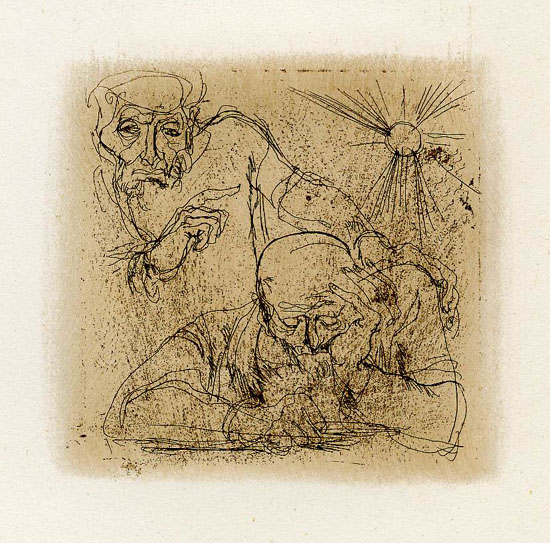
The image of the butterfly burnt in the flame of the candle was also known in European classical literature. Erasmus in Adagia 1.9.51, Pyraustae exitus – “Death of the fire-insect” – cites a fragment of Aeschylus as its earliest occurrence, which has survived just because it had been cited as a proverb already in the antiquity and included in Greek proverb collections: Δέδοικα μωρόν (correctly μῶρον) κάρτα πυραύστου μόρον, that is, among all follies the greatest folly is the death of the butterfly in the fire. The less flattering this opinion is, the more it renders palpable the already mentioned difference of the Greek and Persian world views. Accordingly, Erasmus interpreted the proverb as related to hastiness and ephemeral things. And Sebastián de Covarrubias emphasizes in his great encyclopedia that the butterfly is “the most stupid animal among all”.
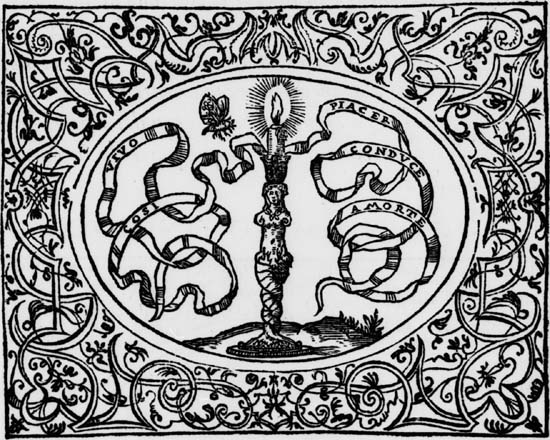
In the West this motif was connected with love only two thousand years after its birth. It was Petrarch who in his 141st sonnett compared the eyes of the beloved lady to the flame, and himself to the butterfly circling around it. This metaphor was made popular in the Petrarchist poetry of the 1500s, exactly when Europe got into contact with Persian culture.
A pictorial form was given to the idea for the first time by polyhistor Gabriele Simeoni, the alumn of the humanist bishop Paolo Giovio whose main work, the History of Italy was already quoted by us a propos of the destruction of the Pope’s rhinoceros. The other, much slimmer but the more influential main work of Giovio was the Imprese militari et amorose, first published in 1550, in which he collected the personal symbols – imprese – of the most illustrious people of the previous half century. An enlarged edition was published in 1574 by Simeoni, who added forty or so imprese of his own invention. Number 15 was the above image, provided by him with the following explanation (first we quote the short version of the 1585 English edition, and then the original 1574 Italian version with our own translation):
Vnder the figure of the butter flie, who so much delighteth in the brightnes of the fire, that of her owne accord she casteth her selfe into the same, and so is burned: may be signified, how that a man who goeth about, or affecteth euerie thing without deliberation and choice, getteth many times to himself shame, reproch and destruction withall.
Vn Gentil’ huomo amico mio mi ricercò di ritrouargli vn’impresa d’amore, ond’ io gli feci disegnare vna Farfalla intorno à vna Candela accesa con queste parole, COSI TROPPO PIACER CONDVCE A MORTE. seguendo la natura di cosi semplice animale, che i Greci dall’amar naturalmente il fuoco han chiamato πυραυστὴν auuertendo che’l senso di questa impresa può essere inteso doppiamente, conciò sia che appropriandolo al corpo, ei non è dubbio alcuno (secondo Platone) che vno innamorato è morto in se stesso, viuendo il suo pensiero (che è la propria vita dell’anima) intorno alla cosa amata. Onde il detto Filosofo soleua dire quand’ ei trouaua vn’innamorato, COLVI VIVE IN VN’ ALTRO CORPO. Ma attribuendo moralmente quest’ amore all’anima, egli è certissimo che mentre che l’huom si deletta intorno à vna bellezza corporale (figurata quì da me per lo splendore della Candela) dimenticando bene spesso il Creator per la creatura, e cadendo in qualche scandolo, vengono finalmente à perdere il corpo e l’anima. Il che accade ordinariamente à certi ricchi sciocchi innamorati, che volendo parlar di amore non sanno in qual parte del corpo eglino s’habbian la testa.
A noble friend of mine asked me to prepare him an amorous impresa. I have designed a butterfly flying around the flame of a candle with these words: COSÌ TROPPO PIACER CONDUCE A MORTE (SO DOTH PLEASANT DELIGHTS LEADE TO DESTRUCTION [Petrarch]), thus displaying the nature of this animal which, as it loves fire so much, was called πυραυστὴς by the Greek. This impresa can be interpreted in two ways. First, applied to the body, there is no doubt that, as Plato says, he who is in love has died for himself, and in thought (which is the life of the soul) he lives in the object of his love. This is why this philosopher told when encountering someone in love: This lives in another body. However, if we attribute love in a moral sense to the soul, then we can often observe that one delighted by corporal beauty (represented here with the light of the candle) forgets the Creator for sake of the created, and falling into scandal he finally loses both his body and his soul. As it usually happens with some stupid rich young people who, speaking about love, do not clearly know in which part of their body their head is to be found.
The invention of Simeoni has made a nice carreer in the flourishing symbolic literature of the 16-17th century. The essence of this refined society play called the emblem game by modern literature, which has left more than a million emblems to us (and how many times more must have perished!) was that poets and artists took their central metaphors from a well-known stock of symbols popularized by emblem books, and changed just subtly their allusions which was perceived with a great delight by the connoisseurs. The modern equivalents of this cultural play can be recognized by everyone in his/her own subculture even today.
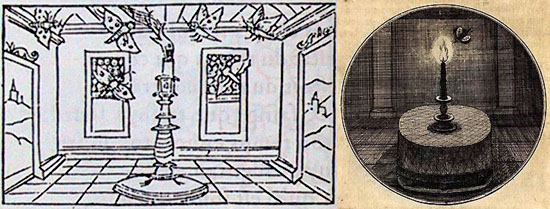
Even before Simeoni it was attempted to make this motif part of the European visual imagery. Gilles Corrozet included it in his emblem book of 1543 with the motto La guerre doulce aux inexperimentez, “sweet is war for the inexperimented” (above left), echoing the celebrated pacifist chapter Dulce bellum inexpertis by Erasmus, to which a special section was dedicated in Pierre Bayle’s great Dictionnaire of 1695. This attempt to convert the chapters of Erasmus’ great collection of ancient proverbs, the Adagia into “visual proverbs” was characteristic of the early emblematics (this genre has been established in the 1530’s). In the case of this motif, however, Simeoni’s amorous interpretation proved to be much more successful than Corrozet’s anti-war interpretation. This latter only found one single echo in Juan Borja, Embassador in Prague (1581) whose emblem with the motto Fugienda peto, “I wish what should be avoided” (above right, from the 1697 edition) calls the attention to the dangers of the war to be avoided, but right then he interprets them for the inner war between reason and desires.
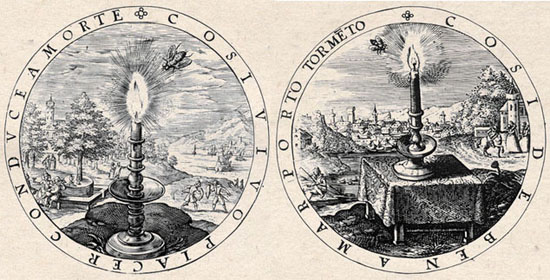

Simeoni’s amorous interpretation was continued by the great Dutch humanist Hadrianus Junius, who in his emblem Amoris ingenuis tormentum, “torments of false love” compared the candle to the woman destroying her lovers, and while dutifully quoting all the classical references of Erasmus, he also added to the citation from Petrarch another from the same author: Così de ben amar porto tormento, “this is how I bear the torments of my true love”. The double motto led to a strange misunderstanding. Gabriel Rollenhagen (above) included the image twice in his great collection of emblems (1611), taking the one from Simeoni and the other from Junius, both with its matching motto. George Wither, who converted Rollenhagen’s volume into the founding work of English emblematics, A collection of emblemes (1635) in fact found suspicious the duplication, and on the second image (to the right) he deleted the flame and the butterfly and changed the motto into Cui bono? that is, what is the use of a candle without light? Perhaps this was the boldest reinterpretation of the image which, however, found no followers. The final version of the symbol, published and painted in several editions, versions and languages, was that of Otho Vaenius in the Amorum emblemata (1608) where its proper meaning was also underlined with a small Cupido added.
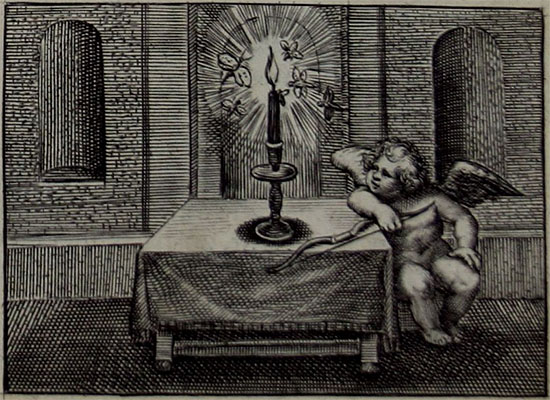
Thus the Persian and European interpretation of this symbol shows a basic difference. Its European interpretation, which has inherited the odium of Aeschylus’ negative judgment – the greatest among all follies – refers to the lover falling captive and then victim to an unworthy – ignoble, humiliating, refused – love. In the Persian tradition, on the contrary, it represents the love of the highest order, aspiring to God and longing for the union with Him. As it was already observed by Hammer-Purgstall, the adventurous Austrian diplomat and orientalist, a first researcher of Persian literature, whose translation of Hafez inspired Goethe’s East-Western Divan: “The butterfly is, for the Eastern understanding, not, as it is for the Western, a symbol of instability and fluttering mind but rather a symbol of the most faithful love, which is oblivious of itself and sacrifices itself.” (Geschichte der schönen Redekünste Persiens). This latter interpretation was also borrowed by Goethe in his poem Selige Sehnsucht.
Therefore the Russian illustration paralleling the earthly love praised by the sceptical Khayyam with the butterflies flying to the flame of the candle is a complete misunderstanding of the Persian tradition. A Persian would never use this latter symbol in a poem or miniature about earthly love, for it represents to him a much higher form of love and union.
In the Western tradition this image occurred one single time as a metaphor of divine love. Saint Teresa of Ávila in chapter 17.7 of the Libro de la Vida, describing the third degree of mystical prayer where will and reason have already settled, but memory still flutters around “like a night butterfly”, says this:
Algunas veces es Dios servido de haber lástima de verla tan perdida y consiéntela Su Majestad se queme en el fuego de aquella vela divina donde las otras potencias están ya hechas polvo, perdido su ser natural, estando sobrenatural gozando tan grandes bienes.
God, feeling pity on this lost condition of her, sometimes permits her to be burnt in the fire of that divine candle which had already reduced the other potencies to ashes, and she, by way of this great act of kindness losing her natural condition, becomes supernatural.
Here, however, the matter is absolutely not the same as in Sufi mystics, that is, the complete solution of the person in God, but only a temporary settling of a human potentia in order the person, preserving his or her own personality, gets into the most personal contact with God. This is the greatest difference between Christian mystics and Sufism, pantheism or ever the Goethean stirb und werde. The God of the Christians, who already includes three persons without melting them, does not abolish the personality of the person uniting with Him, but brings it to perfection. And the metaphor for this kind of union is not the butterfly annihilated in the fire, but rather two other images which are known both by the Western and the Persian tradition, but which were used in this sense only in the West: the phoenix reborn from the fire and the salamander which finds in the fire its final home and greatest perfection.
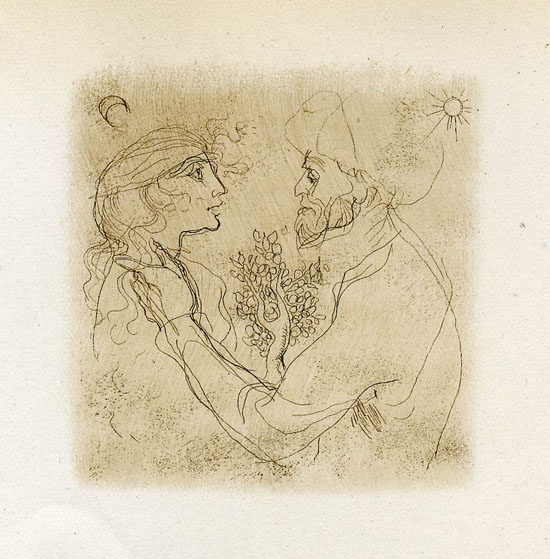

























































3 comentarios:
¡Preciosa entrada y reflexión!
Me gustaría saber, con respecto a lo planteado en el último párrafo, cuán diferente es la mística sufí de la mística afectiva de San Juan de la Cruz.
Sé poco y nada de San Juan, pero sí recordaba, y ahora confirmo, esos versos del "Cántico Espiritual" donde se expresa la unión de la Esposa y el Esposo Amado (el alma y Dios). Es en la sección final en donde la esposa dice
"Gocémonos, Amado,
y vámonos a ver en tu hermosura"
Y más adelante sigue diciendo
"...y luego me darías
allí tú, vida mía,
aquello que me diste el otro día.
El aspirar del aire,
el canto de la dulce filomena,
el soto y su donaire,
en la noche serena
CON LLAMA QUE CONSUME Y NO DA PENA"
¿Puede ser que esa llama que consume y no da pena sea más cercana a la mística sufí, o de todas formas las diferencias son notables?
Sugiero esto teniendo en cuenta especialmente que en los Comentarios en prosa al "Cántico Espiritual" San Juan explica esa unión entre esposa y amado como una TRANSFORMACIÓN. Es decir, no como un instante que luego se desvanece (de los que hay más ejemplos tal vez en la poesía de Fray Luis de León), sino como un cambio verdadero en el que se deja de ser lo que se era; en el que se produce esa idea de la transformación de los amantes, que estudia Guillermo Serés en su libro y que tuvo tanta trascendencia en la literatura que habla del amor humano pero también, como aquí, del amor divino.
Fascinante tema el que propone la entrada. Ojalá nos cuentes más sobre él.
Dear Julia,
Juan also makes clear some basic points in his explanation given to the verse “Con llama que consume y no da pena”. Primarily that here he does not speak about a “simple” union with God, but about the admission into the community of the God as Trinity. Christian mysticism is based on the faith and experience (!) of the Trinity. This makes it basically different from whatever else usually called mysticism.
In the Christian tradition it is quite common to speak about “man’s becoming God”. If I remember well, it was Saint Athanasius who used for the first time the formula “God became man so that man could become God”. Juan also uses similar formulas. But in several places, including in the explanation to this very verse, he clearly explains what Christianity means by this: man’s share in the divine nature. One would “properly” become God if he did it both by essence and by nature. Here, however, the case is something else: that God gives a share from what He completely possesses, that is from the divine nature, to man, to each person, in the extent as He judges it the best. This makes it possible to one to participate in the life of the Trinity.
The acceptance of divine nature produces a truely veritable transformation in human nature. In the description of this process Juan again and again emphasizes that although God exclusively turns with love to man, nevertheless because of the impurities and weaknesses of man, this love in certain phases of unity causes pain to man. With the verse “Con llama que consume y no da pena”, as he himself explains, refers to these expositions. The whole process is just the opposite of an annihilation or melting into the godhead. The person, by the love of God, even if through a painful process, gets rid of all those stains which obstacle him in completely receiving the love of God and thus completely becoming him/herself.
With love, Kata
¡Muchas gracias, Kata!
Todo ha quedado más claro luego de leer tu completa explicación. Aunque tal vez "claridad" no sea el término más exacto para describir esas experiencias tan asombrosas... o sí, no lo sé!
Me doy cuenta ahora de que, como imaginaba, mi duda o confusión sobre las semejanzas entre el misticismo Sufí y el de San Juan, se fundan en que están muy arraigadas en mi mente las concepciones cristianas y occidentales, y por lo tanto en la dificultad para comprender el real sentido de la anihilización.
Con respecto a la transformación para alcanzar un estadio de identidad más verdadera, pienso en la idea de origen agustiniano que conozco porque Cervantes la recrea varias veces en su Persiles: el alma del hombre está en continuo movimiento y no puede descansar verdaderamente hasta alcanzar a Dios, que es su centro. No sé si es correcto, pero me ayuda a representarme aquel pensamiento de la identidad que se alcanza cuando en realidad se produce una transformación.
Con cariño,
Julia
Publicar un comentario